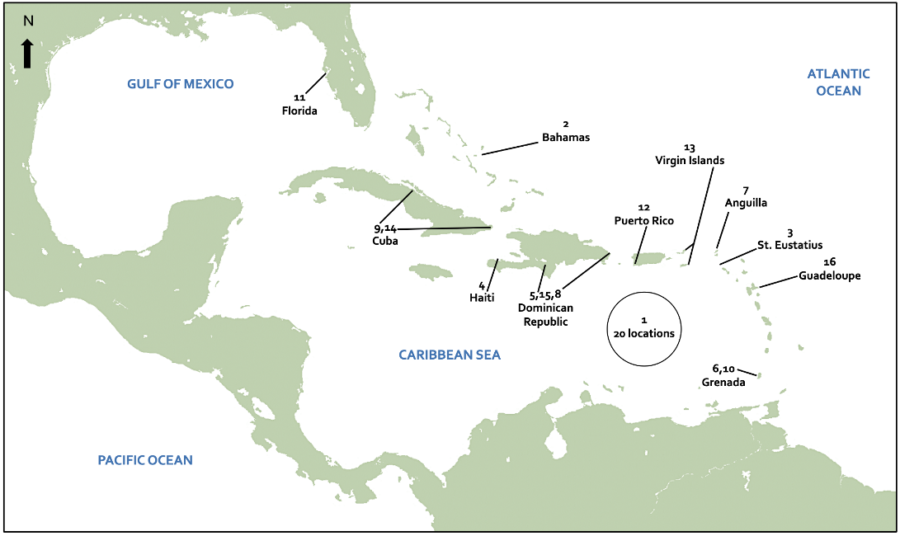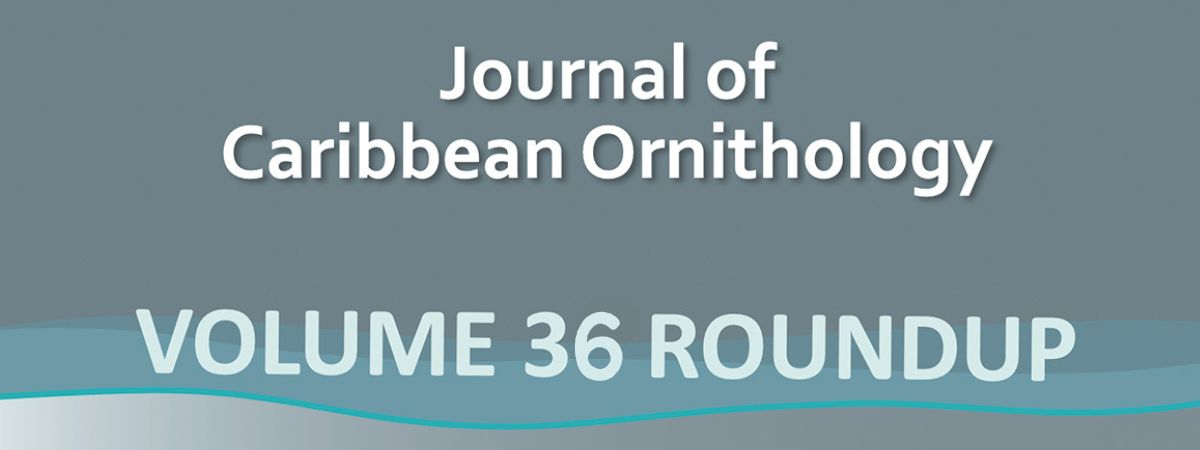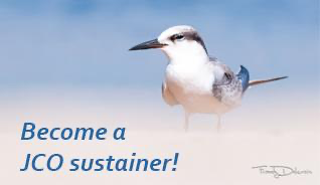The Journal of Caribbean Ornithology publishes peer-reviewed science on Caribbean birds and their environment that is critical to informing conservation work. In this annual blog feature, JCO’s staff is proud to show off the amazing research from scientific teams around the Caribbean. Volume 36 demonstrates the wide range of research conducted by our authors; from population and habitat use studies, to documentations of behavior, to methods-centered papers on bird monitoring. About ten articles focus on land birds, while three concentrate on waterbirds.
The JCO is immensely grateful for its dedicated team of editors, reviewers, copyeditors, translators, proofreaders, and production specialists that have worked together so well again this past year to produce high-quality publications. We also thank the 57 authors behind the 16 Research Articles and Notes for their trust in the JCO to publish their open-source work in the best form. The JCO and our non-profit publisher, BirdsCaribbean, continue to emphasize support for early-career researchers, trilingual content, open access, and a comprehensive archive going back to the very first volume from 1988.

A few glimpses behind the scenes of JCO’s operations in 2023:
JCO has welcomed Dr. Susana Aguilar, our Birds of the World (BOW) Coordinator for Cuba. Susana has an intimate knowledge of Cuban ornithology and we are very happy that we could recruit her to facilitate the revision of BOW accounts from the largest Caribbean island. Our Production Assistant and Designer since 2019, Diane Tessaglia-Hymes is pursuing another professional opportunity. She has tremendously helped with typesetting and, being an Adobe InDesign wizard, has optimized several “under the hood” features. Our Associate Editor team expanded with Yvan Satgé of Clemson University and Dr. Kathryn Peiman, from Ontario, Canada joining the team. Sadly, we learned that one of our Associate Editors, Dr. Virginia Sanz D’Angelo (Centro de Ecología, IVIC, Caracas, Venezuela) has passed away. Her dedication to JCO leaves a big gap.
It took a little longer than hoped, but our (all part-time!) staff finally pulled together a voluminous (94 pages) Special Issue with Caribbean-themed conference contributions from the AOS-BC conference in San Juan in 2022. Because it sometimes takes authors a while to fully publish research, these conference presentations and poster abstracts provide a more timely glimpse into what’s happening in Caribbean bird research and conservation.
We hope to see many of our readers, authors, editors, and team members in July at the BirdsCaribbean 2024 Conference in the Dominican Republic!
— Joseph M. Wunderle, Jr., JCO Editor-in-Chief,
— Stefan Gleissberg, JCO Managing Editor
— Zoya Buckmire, JCO Lead Copyeditor
The Journal of Caribbean Ornithology relies on donations to keep all of our publications free and open-access. Support our non-profit mission and give a voice to Caribbean ornithologists and their work by becoming a supporter of JCO. Consider being a sustainer with a monthly contribution of $5 or more!
RESEARCH ARTICLES AND NOTES
Meghann B. Humphries and Robert E. Ricklefs
Like humans, birds are susceptible to parasitic infections, including avian malaria, and similarly, variations in hemoglobin structure may influence their susceptibility to these infections. Using one of the most widespread West Indian species, the Bananaquit (Coereba flaveola), Humphries and Ricklefs aimed to relate variation in hemoglobin structure and avian malaria infection across several islands. In this paper, they present the results of this fascinating study, with suggestions for appropriate markers for further biogeographic analyses.
Graham Reynolds and Sandra D. Buckner
In the midst of the central Bahamas archipelago lies the tiny Conception Island National Park. This multi-island park is designated as an Important Bird Area, but until now, its bird diversity was poorly documented. In this paper, Reynolds and Buckner present the first avifaunal list for this park in over a century, with a whopping 68 species, 3 of which are Bahamian endemics.
Hannah Madden and Hailley Danielson-Owczynsky
As human influence over the environment increases, so too does the distribution of artificial materials in natural spaces. More and more birds are encountering human debris in their habitat and interacting with these materials in various ways—whether mistaking them for food or becoming entangled in them. In this research note, Madden and Danielson-Owczynsky document landbirds in St. Eustatius using human debris in an interesting but dangerous way, a fascinating discovery that hints at the pervasiveness of our impact on the world around us.
Anderson Jean, Maxon Fildor, Marta Curti, Eladio Fernandez, Christine D. Hayes, and Thomas I. Hayes
Few things are more exciting than the rediscovery of a once-extirpated species, and the case of the Ridgway’s Hawk (Buteo ridgwayi) is no exception. This Hispaniolan endemic was once well-distributed across the island, but had not been recorded in Haiti since 1962. A chance encounter in 2019 prompted hope and follow-up studies in subsequent years as the authors sought to confirm sightings of the species. In this research note, Jean et al. document their rediscovery of this unique hawk in Haiti.
Joshua LaPergola, C. Justin Proctor, Hodali Almonte, and Kate J. Wallace
Birds eat bugs—or at least, that is how it’s supposed to go. The roles are sometimes reversed in the natural world, with one noteworthy example being parasitism. Philornis sp. larvae are a well-known parasite for birds, but we are still figuring out which species are affected by these parasites. In this paper, LaPergola et al. document the first record of Philornis sp. larvae parasitizing a swift, in this case an Antillean Palm-Swift (Tachornis phoenicobia) in the Dominican Republic. This expands our understanding of parasitism by this genus and adds to the ever-growing list of threats to Caribbean birds, especially aerial insectivores like swifts.
Nicholas Bergen, Christopher C. De Ruyck, and Nicola Koper
Citizen science provides a seemingly obvious solution to the various logistical and resource challenges of data collection in the Caribbean, but it is not without its own challenges. How does observer experience affect detectability of birds in the field? And do observers perform differently depending on who they are paired with? Bergen et al. conducted an experiment in Grenada to answer these questions and more, involving 34 different observers in over 400 surveys across the island. In this paper, the authors present the results of their study, along with several practical recommendations for the design and implementation of citizen science-based monitoring programs in the region.
Louise M. Soanes, Devon Carter, Laurel B. Symes, Jennifer C. Daltry, Holger Klinck, Clarissa Lloyd, and Farah Mukhida
If we as scientists had unlimited time and money, then long-term monitoring of bird populations would be a breeze. In the real world, however, monitoring efforts are limited by funding, access, and personnel, especially on remote islands and cays. Passive acoustic monitoring (PAM) is an emerging tool with the potential to significantly increase the efficiency of monitoring efforts, and a recent pilot project in Anguilla aimed to test the utility of this tool in the Caribbean context. In this paper, Soanes et al. describe the results of their pilot, with recommendations for the best use of PAM throughout the region.
Samantha J. Hagler, Kara Abbott, Christine D. Hayes, Thomas I. Hayes, and André A. Dhondt
The Critically Endangered Ridgway’s Hawk (Buteo ridgwayi) is a charismatic species that has received lots of conservation attention in recent years, but there still remain major gaps in knowledge about this species’ life history and behavior, especially pre-breeding. In this research article, Hagler et al. present their results from tracking 3 established breeding pairs of Ridgway’s Hawks in the Dominican Republic, adding critical information to the body of knowledge about this endangered and endemic species.
Yaroddys Rodríguez Castaneda y Nils Navarro Pacheco
The wild bird trade is a growing threat to Caribbean birds, with species targeted for their bright plumages and/or beautiful songs. This industry is especially prevalent in Cuba, with over 3,000 birds trapped in one month (October 2021). Dozens of species are trapped and sold, including species that may not have been previously recorded for the island. In this Spanish-language paper, Rodríguez Castaneda and Navarro Pacheco document a new species for Cuba, discovered through the ongoing bird trade, suggesting that Cuba’s true avian diversity may be even higher than estimated.
El tráfico de aves silvestres es una amenaza creciente a las aves del Caribe, con las aves elegidas para sus plumajes brillantes y/o sus bonitos cantos. Esta industria es especialmente frecuente en Cuba, con más que 3000 aves capturadas en un mes (octubre 2021). Docenas de especies son capturadas y vendidas, incluyendo unas especies que quizás no eran reportadas para la isla. En este artículo español, Rodríguez Castaneda y Navarro Pacheco documentan una especie nueva para Cuba, descubierta por el tráfico continuado de aves, sugiriendo que la verdadera diversidad de aves de Cuba puede ser aún más alta que la estimada anteriormente.
Ramon J.T. Williams, Miyako H. Warrington, and Nicola Koper
Small Island Developing States (SIDS) are subject to unique ecological pressures, and the bird populations on these islands are no different. How are birds using and responding to natural and anthropogenic habitats on these islands? In what ways does this use differ from the well-studied continental regions? And importantly, how does this inform conservation and management measures here, in the Caribbean? In this paper, Williams et al. explore all these questions and more using resident landbird species in Grenada.
Kara L. Lefevre, Elizabeth Forys, Adam DiNuovo, and Adam D. Smith
Black Skimmers (Rynchops niger) are a charismatic—and admittedly odd-looking—colonial seabird distributed throughout the coastal Americas. Populations in Florida (R. niger niger) are under threat, and to inform conservation measures, Lefevre et al. set out to track the dispersal and movements of skimmer chicks from breeding colonies in Florida. In this paper, the authors describe their use of various tracking methods, some more successful than others, and present important recommendations on how to design future studies.
Wilfredo Falcón and Raymond L. Tremblay
Parrots and parakeets (Psittaciformes) are some of the most widely introduced species in the Caribbean, and Puerto Rico is no exception. There, the White-winged Parakeet (Brotogeris versicolurus) was introduced in the late 1960s and has since become “the most successful invasive psittacine species on the island”. However, until now, not much was known about their life history or population status in Puerto Rico. In this article, Falcón and Tremblay report on the status of two breeding populations with estimates of their growth rates, as well as other critical information including the species’ diet and nesting habits on the island.
Paige A. Byerly, Susan Zaluski, Daniel Nellis, Judy Pierce, and Paul L. Leberg
Effective management of bird populations requires quality data, but quality data is often difficult to come by. Where studies do exist, methods may vary greatly based on differing research questions, objectives, and priorities, but as Byerly et al. demonstrate here, it is not impossible to form a cohesive picture from various disparate surveys. Comparing data from surveys in the early 2000s with their own in 2016-2018, the authors produce up-to-date trends on the populations of 7 seabirds in the Virgin Islands—and none of them are good. In this paper, Byerly et al. present these timely population status updates, a call for action, and a great example of how to make the best of the limited data we have in the Caribbean to conserve and manage our birds.
Nils Navarro Pacheco, Roberto Jovel Lara, Wisdenilde Navarro Méndez, Juan Carlos Lobaina Montero, Noel Coutín Lobaina, and Carlos Hernández
The Cuban subspecies of the Sharp-shinned Hawk (Accipiter striatus fringilloides) is relatively understudied, with no documented nesting records for Cuba—until now. In this Spanish-language article, Navarro Pacheco et al. present the first record of a nest found in Guantanamo, Cuba, with detailed descriptions of the nest, eggs, breeding behavior, and other aspects of the reproductive biology of this endemic subspecies.
El Gavilancito Cubano (Accipiter striatus fringilloides) es relativamente poco estudiado, con ningunos registros de nidificación documentados para Cuba—hasta ahora. En este artículo español, Navarro Pacheco y otros presentan el primer registro de un nido encontrado en Guantánamo, Cuba, con descripciones detalladas del nido, los huevos, el comportamiento de reproducción, y otros aspectos de la biología reproductiva de esta subespecie endémica.
Avery Young, David Aborn, Steven C. Latta, and Jennifer Nagel Boyd
The way wildlife interacts with food systems is an increasingly important topic as food production expands and encroaches upon habitat. In the Dominican Republic, a major driver of habitat loss is the conversion of forests to avocado farms to meet demand. How does habitat differ between the natural forests and these farm systems? How are birds responding to these differences? And does avian response vary depending on whether the birds are endemic, resident, or migratory? In this research article, Young et al. answer these questions and more, and offer recommendations to balance habitat preservation with our food production needs.
Malo Braquier, Anthony Levesque, Jérémy Delolme, and Charlotte Francesiaz
How long do birds live in the wild? Lifespan of course differs by family and species, and even within species as birds face varying threats within their habitats, migration routes, and from the humans they encounter. Shorebirds like plovers can live into their teens, and for the Wilson’s Plover (Charadrius wilsonia), the previous longevity record was 10 years. In this research note, Braquier et al. report a new longevity record for this species from their resightings of a previously banded Wilson’s Plover in Guadeloupe.
BOOK REVIEW
Birds of the Lesser Antilles
Book Author: Ryan Chenery
Book review by: Steven C. Latta
RECENT ORNITHOLOGICAL LITERATURE (ROL) FROM THE CARIBBEAN
Recent ornithological literature from the Caribbean – 2023
Steven Latta
The annual compilation of the most important articles that appeared elsewhere, annotated by Steve Latta.
Article by
Zoya Buckmire – Lead Copy Editor for the Journal of Caribbean Ornithology;
Stefan Gleissberg – Managing Editor JCO
The Journal of Caribbean Ornithology relies on donations to keep all of our publications free and open-access. Support our non-profit mission and give a voice to Caribbean ornithologists and their work by becoming a supporter of JCO.


